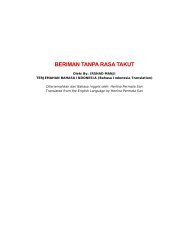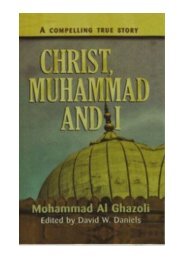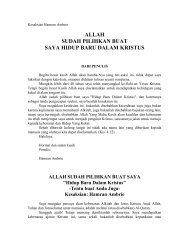A Critical Analysis of 'Real Islam'. Its People ... - Bukti dan Saksi
A Critical Analysis of 'Real Islam'. Its People ... - Bukti dan Saksi
A Critical Analysis of 'Real Islam'. Its People ... - Bukti dan Saksi
Create successful ePaper yourself
Turn your PDF publications into a flip-book with our unique Google optimized e-Paper software.
Chapter 2<br />
‘Real Islam’ from the Religious Texts<br />
"Real Islam" is the way <strong>of</strong> living the ‘Messenger <strong>of</strong> Allah’ (Muhammad) practiced and taught, as it is<br />
understood by the majority <strong>of</strong> Muslims today. To understand how Muslims think and what they really<br />
believe today, we need to look carefully at the material they have been taught from. One can also look at<br />
the history <strong>of</strong> the different sects within Islam, but all real Islamic philosophy is fully contained in its<br />
recognized scripture. By Muslim belief and understanding, no prophet can or will follow Muhammad, and<br />
so no further scripture will ever be <strong>of</strong>fered to challenge or replace the existing works. Within several<br />
centuries <strong>of</strong> Muhammad’s death, Muslim theologians and jurists, Sunni (including all four main schools<br />
<strong>of</strong> jurisprudence), Shiite, and Sufi (both Sunni and Shiite), constructed from Qur’anic verses, the hadith<br />
collections, and the sacred biographies <strong>of</strong> Muhammad (the Sira). These foundational texts <strong>of</strong> Islam<br />
contain Muhammad’s words and deeds over a 23-year period, the Qur’an being dominant in Islamic<br />
theology. But even the Qur’anic suras are not given equal weight. As will be shown, the most applicable<br />
part <strong>of</strong> Islamic theology is based more heavily upon Muhammad’s final teachings and deeds than earlier<br />
writings. This work endeavors to uncover these most important final teachings, exactly as recorded in the<br />
Qur’an, using chronology and context identified by the Hadith (the traditions and sayings <strong>of</strong> Muhammad),<br />
and the biographical material in the Sira.<br />
In studying the scripts, it needs to be remembered that many <strong>of</strong> his words are understood to apply<br />
only to a specific people for a specific time or event. It appears that as Muhammad’s circumstances<br />
changed, his words, teachings, commands, and attitudes also sometimes changed. Thus, as situations<br />
changed over time, Muhammad’s words and teachings morphed to accommodate them, and so real Islam<br />
also changed over time. In the end, at Muhammad’s death, the philosophy and conduct <strong>of</strong> Islam and its<br />
followers solidified to a more stable and recognizable form. Therefore, to determine what real Islam<br />
teaches regarding Jihad and violence, we must examine these text’s chronology, context, scope, and<br />
applicability. It is either mistaken or dishonest to take one passage out <strong>of</strong> context and apply it to a set <strong>of</strong><br />
circumstances for which it was not meant.<br />
What we are going to do is examine a number <strong>of</strong> Qur’anic passages related to Jihad and violence.<br />
Citations obtained from related Islamic texts (the Hadith and Sira) are also presented to provide<br />
background, context, and chronology. Additionally, various references and commentary from early<br />
Islamic scholars’ (tafsir) will be presented. When appropriate, quotations will be presented by other<br />
historians, scholars or experts on Islam, be they Muslim, Christian, or secular.<br />
After this, we are going to go a step further. We are also going to examine Muhammad’s actions.<br />
Actions ever speak louder than words; therefore, let us lend an ear to hear what it is that his deeds speak<br />
about the man. A wise sage said, "A man is defined by what he does." Thus, Muhammad’s works must be<br />
thoroughly scrutinized, for surely they truly portray his heart and show us who he was, and what he truly<br />
believed. This is all the more important in our study because Muslims relationship with the God they<br />
worship is by and through the words and example <strong>of</strong> their beloved prophet. The absolute truth accepted<br />
by all Muslims is that Muhammad was the ‘seal’ <strong>of</strong> the prophets, or the last and final representative <strong>of</strong><br />
God. Essentially, they believe that God completed his delivery <strong>of</strong> all revelation and instruction to men by<br />
the words and example <strong>of</strong> His final ‘Messenger’, and that new revelations or prophets are no longer<br />
possible. So the works mentioned, which contain the teachings and example <strong>of</strong> Muhammad, is all there is<br />
for Muslims to follow and pattern their lies after.<br />
We will also briefly review what Muhammad’s closest "companions" understood to be his final<br />
wishes, which direction they believed were the commands <strong>of</strong> God to His messenger or apostle. We will<br />
refer to the four "rightly guided" Caliphs: Abu Bakr, Umar, Uthman, and Ali. These four hold a special<br />
place in Islamic theology and history. If anyone knew what Muhammad truly wanted, they did. Following<br />
Muhammad’s death, they continued to fulfill and obey his commands, as they understood his final clear<br />
directions and wishes. They loved Muhammad, obeyed his commands, and put their lives on the line for<br />
him time and again. Hence, we can safely assume that their actions accurately depict their understanding<br />
<strong>of</strong> how Muhammad wanted them to carry on Islam (i.e. real Islam).





